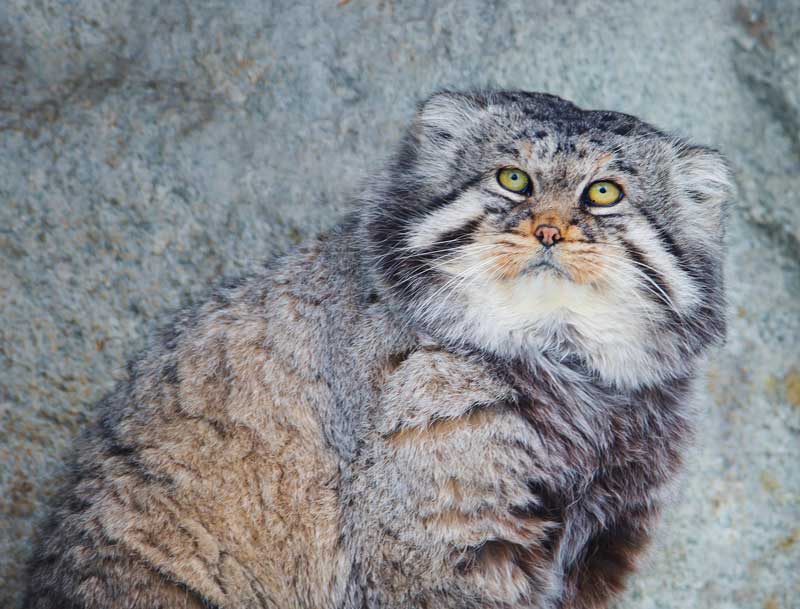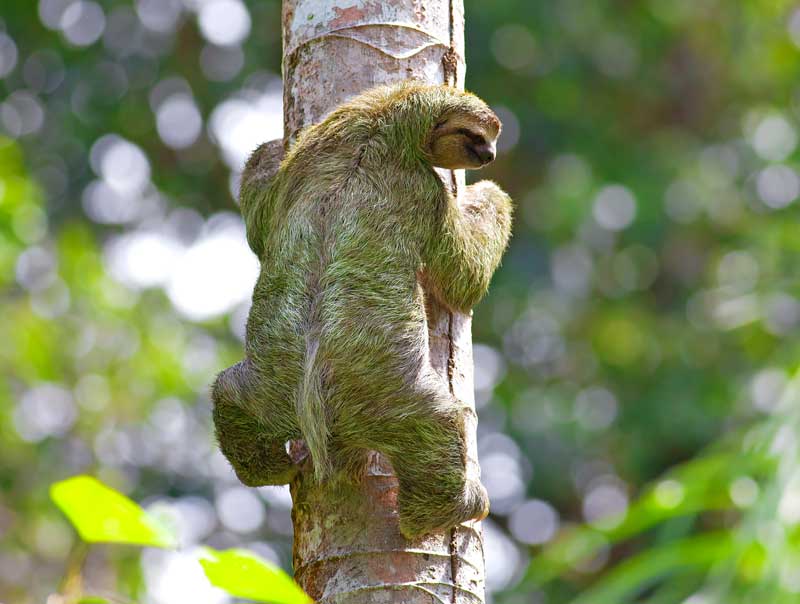|
Continuing with the theme of RIDICULOUSLY CUTE WILD CATS.
Did you know the Pallas's cat is a small, stocky, bushy cat that lives in cold rocky areas of Central Asia? They have short legs and are slow runners. These cats have such long, thick fur that their ears are barely visible. This makes them look a little bit like domestic Persian cats. It turns out, though, that Persian cats are not derived from Pallas's cats. Weighing 4 to 7 pounds (1.8 to 3.2 kg), the Pallas's cat (also called the manul) uses its camouflage and low body profile to hunt prey and avoid predators such as wolves, eagles, and snow leopards. Instead of chasing down their prey, these cats are ambush hunters. They often sit and wait for rodents to come out of their burrows, and often they thrust a paw into the burrow to try to snag the prey. They sometimes eat lizards and birds, but they especially like small mammals like gerbils, voles, hamsters, pikas, and small marmots. Most cats have vertical-slit pupils, but the Pallas's cat has round pupils. Unlike domestic cats, the Pallas's cat does not meow. Instead, it growls, yelps like a small dog, and purrs.
0 Comments
Continuing with the theme of RIDICULOUSLY CUTE WILD CATS.
Did you know there is a small wild cat called the margay that is so good at climbing trees that it can run down a tree trunk headfirst? Weighing less than 9 pounds (4 kg), margays have an extra-long tail, which helps them keep their balance while maneuvering through the trees. Also, their ankles can rotate 180 degrees (like a squirrel!). Margays live in Central and South America and are related to the larger ocelot. Normally hunting in trees, they are ambush hunters, waiting patiently for the perfect time to pounce on a monkey, bird, lizard, tree frog, or large insect or spider. They also raid bird nests and eat the eggs. Amazingly, margays have been observed mimicking the sounds of small monkeys as a hunting strategy. The monkeys, attracted by the mimicked sounds, come close enough for the margay to pounce. Male Margays perform an elaborate "dance" sequence to woo their mates. When in estrus, the females attract males with a long, moaning call. When the males approach, they yelp and trill, and rapidly shake their head back and forth, a mating ritual not seen in any other types of cats. For the next few posts, I'm focusing on the theme of RIDICULOUSLY CUTE WILD CATS.
Did you know there is a tiny wild cat, called the sand cat, that inhabits extremely dry deserts of Africa and the Middle East? The sand cat (with the awesome scientific name of Felis margarita) only weighs 3 to 7 pounds (1.4 to 3.2 kg), and has an unusually wide face. Sand cats sleep in their burrows during the day and come out at night to hunt small rodents, birds, lizards, insects, spiders, and even venomous snakes. They hunt by skulking around with their ears close to the sand, using their super-duper hearing ability to detect animals digging or slithering underground. When they hear one, they start digging really fast to get to the prey animal before it escapes. Sand cats regularly go weeks at a time without drinking water, getting the moisture they need from the bodies of the prey animals they eat. The photo below is a wild sand cat... not a domestic cat. Did you know sloths are so slow that algae grows on their fur? Well, algae does grow on their fur, but not necessarily because they are slow moving. Sloths have actually formed a symbiotic relationship with the algae. So, sloths actually encourage the algae to grow on their fur. The green color helps camouflage the sloth.
Here's the thing. Mammals can't be green. Why not? Because Mammal hair only has two kinds of pigment: one that creates black or brown hair and one that creates yellow or reddish-orange hair. No green. Unless the mammal gets some help. Sloth hair is long and coarse, and individual hairs have (depending on sloth species) either grooves or cracks that provide the algae a place to grow. What do the algae get out of the deal? Shelter and a good supply of water. In addition to camouflage, the sloths also get additional nutrients that they absorb through their skin from the algae. Scientists have found that each species of sloth hosts a specific type of algae, which doesn't live anywhere else in the world other than on those sloths. Because of this, baby sloths get their supply of algae directly from their mother. It is thought that sloths have had this arrangement with algae for more than 20 million years. Did you know a pigeon saved nearly 200 U.S. troops in World War I? In 1918, In the final weeks of the war, 194 American soldiers were trapped and were being attacked by advancing German troops as well as allies who mistook them for enemy forces. They had no way to get the word out that they needed help—except for three carrier pigeons they had with them. They attached a message to one of the birds and let it loose. Enemy soldiers promptly shot it down (they probably carried shotguns loaded with birdshot for this very reason). The Americans released the second bird, and it was also shot. They had one pigeon left, a bird named Cher Ami. They attached a message and let the bird fly. Cher Ami was hit by several pellets, but he survived and was able to deliver the critical message. The soldiers were saved. Cher Ami the pigeon was awarded the Croix de Guerre, which was an honor given to foreign troops by the French Army. The photo below shows troops fastening a message to a pigeon in May of 1917. Photo Credits: - Carrier pigeon in WW1 - Castle, W.I. (William Ivor), official Canadian war photographer, Public domain, via Wikimedia Commons Did you know an Arabian camel can drink thirty gallons (114 L) of water in only thirteen minutes? Arabian camels, sometimes called dromedaries, are highly adapted to desert life. These are the one-hump camels (Bactrian camels are the two-hump camels). The camel's body stores up to eighty pounds of fat (not water) in the hump. During extended times without water, the camel can convert the fat into water and energy. Astoundingly, this allows a camel to walk up to a hundred miles without a single sip of water.
So, when camels finally have access to a water source, they take water-snarfing to a whole new level, sucking in thirty gallons. Topping off the tank, as they say. Camels have various adaptations to conserve their water. For example, they hardly ever sweat, even when the desert is 120 degrees F (49 C). Also, a camel's kidneys work overtime, creating highly concentrated urine, minimizing water loss. By the way, camels originated in North America and eventually spread across the Bering Strait to the Old World. Arabian camels have been domesticated for at least 3,000 years, and possibly for as long as 6,000 years. Very few wild camels still exist, although there are some small groups of feral camels (escaped or released). Did you know rabbits do not have pads on the bottoms of their feet? You know what paw pads are, right? Those thick, leathery pads you see on the feet of cats and dogs (and many other mammals). Those pads cushion the feet, provide traction, provide stability when running, and allow animals to move quietly.
But rabbits, hares, and pikas (the mammals that make up the group called lagomorphs) simply do not have paw pads at all. Instead, they have an extra thick growth of fur on the bottoms of their feet. This thick fur serves most of the same functions as paw pads, providing protection to the feet, stability, and traction. And of course warmth. I've always thought it was a bizarre custom, but when I was a kid (in the 60s and 70s), people commonly carried around a preserved rabbit's foot on their keychain. These could be purchased at many stores and gas stations. If you've ever seen a "lucky" keychain rabbit's foot, you might have noticed it was completely fur-covered, with no paw pads. |
Stan's Cogitations
Everyone needs a creative outlet. That's why I write. Archives
July 2024
|








 RSS Feed
RSS Feed